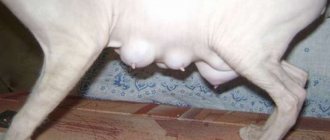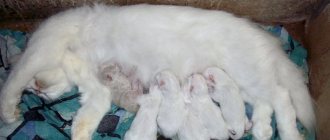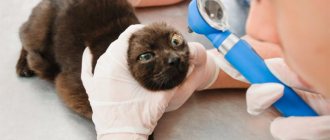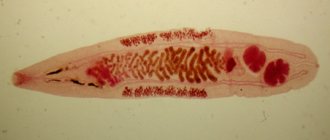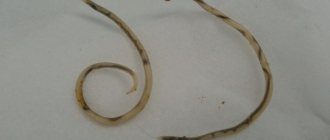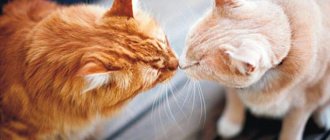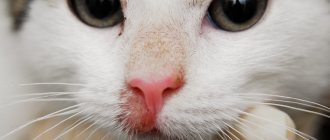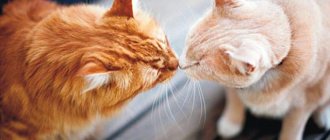Find out now about the types, causes, symptoms and ways to treat mastitis in cats on your own and with the help of medications. Prevention.
Mastitis in a cat is a pathological inflammatory process in one or more mammary glands. Pathology can develop under the influence of various factors: traumatic, thermal, chemical, climatic. The disease most often occurs in lactating cats. Less commonly, the cause of mastitis can be a false pregnancy in a cat.
What are the causes of this pathology, how to find out that a cat has mastitis, whether it can be prevented and how to cure it - you will find answers to all these questions in our article.
Classification of mastitis
Based on the nature of the inflammatory process, mastitis is divided into several types, each of which has its own clinical picture.
Serous
It is characterized by active hyperthermia of one or more mammary glands, the release of serous exudate (opaque liquid) from the nipples. Most often it occurs in the first days after birth due to injuries to the nipples, hypothermia of the cat, and stagnation of milk in the mammary glands. Pathology can also develop under the influence of streptococci and staphylococci, which the animal can become infected with.
Catarrhal
Inflammation usually develops in the milk ducts and alveoli, as a complication that spreads from the skin of the nipples. Only the glandular tissue of the mammary gland is affected. The clinic resembles the serous form of the pathology. The main cause of catarrhal mastitis is considered to be unsanitary conditions.
Purulent
This type of pathology leads to a decrease or complete disappearance of lactation. Characterized by purulent discharge from the nipples. The cat's mammary glands are very hyperemic, the skin around the nipples is red. The abscess area is painful. The animal experiences intoxication and seeks to stop contact with humans and offspring. After this pathology, cats may completely lose the ability to feed kittens.
Fibrinous
Occurs after abortion, delayed placenta, diseases of the uterus and purulent processes in the cat’s genitals. Most often it is a complication of serous and catarrhal mastitis. This type of pathology occurs quickly and severely. The animal's temperature rises to 41°C. The cat is severely intoxicated.
Hemorrhagic
A dangerous form of pathology. Most often it occurs in the first days after childbirth, as a complication of serous and catarrhal mastitis. The cat's mammary gland tissue becomes covered with numerous hemorrhages. The animal's temperature rises to 41°C. The cat is depressed, the glands are very painful. Bleeding is possible. After treatment, the mammary glands may lose their functions.
Gangrenous
Occurs in the absence of treatment for other forms of mastitis. Most often, cats that are in poor sanitary conditions get sick. It is characterized by necrosis (death) of the affected breast tissue. The cat's temperature rises sharply (above 41°C) or also drops sharply. The animal is immobilized. Possible death.
What to do
Depending on the current condition, various treatment methods are available. If your cat is suffering from an infection (as is the case with mastitis), it may require emergency medical attention. Immediate attention is necessary to ensure the cat is stabilized and can receive treatment.
© shutterstock
- Mastitis . Treatment for mastitis includes antibiotics to clear up any infection and pain medications to help your cat cope with the pain associated with the condition. Your veterinarian may also recommend that you apply a warm compress periodically to help with drainage.
- Mammary cancer . This type of cancer is very aggressive and spreads frequently. This usually occurs in several nipples at once. Surgical removal of the affected glands (mastectomy) is recommended, especially if the cancer is in the early stages. If the cat is not suitable for surgery, chemotherapy may be the only treatment option.
- Mammary hypertrophy in cats . The recommended treatment for this condition is complete sterilization (ovariohysterectomy). Although these operations are more routine, if the cat is suffering from general poor health, the procedure can be very tedious.
- Breast hyperplasia . To solve this problem, you need to remove the source of progesterone. This usually results in an ovariohysterectomy. If ulceration of the glands has occurred, they can be removed if the cat is stable enough. Pain medications will be prescribed to help your cat survive the days following surgery.
- Pregnancy or Galactostasis . Both of these causes of breast enlargement will disappear on their own over time.
Causes
The causes of mastitis in cats vary:
- Stagnation of milk due to increased productivity of the mammary glands or early weaning of kittens from their mother.
- General hypothermia of the animal or hypothermia of the mammary glands of a lactating cat.
- Injuries and bruises of the mammary glands or their nipples: cracks, scratches or bites. Traumatic lesions are a gateway for bacteria, viruses and fungi.
- Diseases of the genital organs during pregnancy or after childbirth.
- Abortion or cesarean section, after which the cat cannot feed the offspring for a long time.
- False pregnancy and other hormonal imbalances.
- Immunodeficiency.
- Failure of kittens to use all nipples. This happens if the cat has few kittens or some of the nipples have pathologies (tumors, injuries).
- Postpartum complications and complications after sterilization surgery.
Symptoms
The first symptoms of the disease are difficult to notice, so you need to be an attentive and caring owner - constantly monitor the behavior of your pet.
- The appearance of swelling, compaction and redness in the breast area.
- The gland is hot to the touch and touching it causes pain and discomfort in the cat.
- In the presence of a bacterial infection, discharge of a different nature appears from the mammary gland (purulent, cheesy, cloudy), sometimes an impurity in the form of blood may appear.
- Increased body temperature and lethargic state of the animal.
How to determine what form of mastitis a cat has
Serous:
- one or more lobes of the mammary gland are swollen;
- milk lobes are hot to the touch;
- dense gland;
- the cat does not feel anxious, has a mild pain syndrome, the animal allows itself to be examined, does not meow;
- body hyperthermia may be absent;
- discharge from the nipples is initially yellowish and transparent, then resembles diluted milk with flake-like impurities.
Catarrhal:
- the structure of glandular tissue changes;
- milk turns into flakes that clog the ducts in the nipples;
- milk stagnates and curdles, because of this nodules appear around the nipples, they can be felt upon palpation;
- There may be no body hyperthermia;
- after feeding or pumping, the nodules resolve;
- the cat does not worry and does not experience pain.
Purulent:
- visible decrease in the volume of milk produced;
- discharge from the nipples is cloudy and purulent, has an unpleasant odor;
- the affected lobes of the mammary gland are very swollen and reddened;
- the cat has a fever;
- the animal is oppressed;
- due to severe pain, the cat refuses to feed the kittens, meows loudly and does not allow itself to be examined;
- in a chronic course (more than 21 days), the gland is completely filled with connective tissue, and the cat loses the ability to lactation.
Fibrinous:
- the lobes of the mammary gland appear enlarged, dense to the touch, painful;
- on palpation you can hear a crunch;
- lymph nodes located in close proximity to the diseased lobes are enlarged;
- The cat has a fever.
Hemorrhagic:
- the skin, glands and ducts become covered with hemorrhages;
- the gland is swollen and painful;
- the cat is depressed and has a fever;
- local hyperthermia (milk lobes are hot).
Gangrenous:
- change in color of the mammary glands to brown or blue;
- ulcers and bleeding appear in diseased areas;
- the cat is unconscious;
- the animal has a strong increase in body temperature.
Asymptomatic mastitis
Sometimes the disease occurs without visible symptoms. You can tell that a cat is developing mastitis by the following signs:
- kittens are malnourished and gain little weight;
- the cat is anxious during feeding and licks its mammary glands during breaks;
- kittens are worried and may have an upset stomach due to changes in milk quality.
Why is my cat's nipple swollen?
Any hormonal changes in a cat’s body are not without consequences. For example, the behavior of a pet changes. From a calm “pillow” on the sofa, she turns into a restless, unhappy creature who is worried about something. Or, a swelling or small lump may appear on the nipple, which will disappear in a day or two. But most often, with hormonal fluctuations in a cat’s body, all nipples swell.
It is also important that the cat can also have problems with hormones. Therefore, such a phenomenon as: a swollen nipple can be equally expressed in both male and female cats.
What if the owner notices abnormal phenomena. Such as only one nipple is swollen. What could it be? So what should I do? Wait until other signs of a surge in hormones appear? Change food? Check stool? Look in reference books for clues to similar symptoms? Or should I rush to the doctor with my cat?
© shutterstock
So, only the cat's nipple itself is swollen. And besides its swelling, you can notice other symptoms :
- Redness;
- The cat is lethargic and refuses even its favorite food;
- Perhaps sores have appeared around the nipple;
- When we touch the mammary gland, the cat begins to hiss or quickly runs away (this indicates that it is in pain).
What could it be? There are several explanations for this phenomenon, and it is too early to draw conclusions until the doctor has examined the tumor on the cat's nipple.
And yet, what symptoms of diseases is that the cat’s nipple is swollen?:
- Cancer;
- Mastitis, as a blockage of blood vessels in a cat's nipple;
- Benign tumor.
Treatment of mastitis in cats
What is the danger of mastitis
Mastitis is a rapidly progressing pathology, so if the temperature rises and discharge appears, you should immediately show your cat to a veterinarian.
Firstly, the disease can quickly lead to death, especially if treated untimely and incorrectly.
Secondly, if you continue to feed kittens with toxic milk, the offspring will die.
Thirdly, if treatment is not provided in a timely manner or is incorrect, the mammary gland can degenerate into benign or malignant neoplasms.
How to help a cat at home yourself
As soon as you notice signs of mastitis, the kittens should be isolated from their mother, and the cat should be taken to a veterinarian. The doctor will diagnose the type of mastitis and prescribe treatment.
These activities can be performed at home independently in case of serous and catarrhal forms of pathology in order to alleviate the cat’s condition:
- Gently stroke the belly if the cat does not experience pain. During a light massage, the diseased areas of the gland are covered with a dome-shaped palm.
- Express milk until the firm breast lumps become soft.
- Diseased lobes are sealed so that kittens cannot suck from them. Milk from the affected areas is expressed by a person.
- Limited drinking regime. To prevent milk from flowing too much, water is removed from free access. The cat is given something to drink only immediately after feeding.
- Warm lotions made from herbal infusions.
- Gently rubbing the diseased lobes of the mammary gland with camphor or ichthyol oil. After rubbing, the affected area is covered with thin cellophane and bandaged.
How to make a herbal decoction for lotions
To prepare a herbal decoction, mix chamomile flowers, crushed oak bark and sage leaves in equal proportions. Take 1 tbsp. spoon of the resulting mixture and pour 200 ml of it. hot boiled water. Infuse the resulting mixture in a thermos for half an hour. Then the mixture is filtered and cooled to a temperature of 37-38°C.
Gauze napkins are moistened in the resulting decoction and applied to the diseased areas of the gland. Thin cellophane is placed on top of the gauze and bandaged carefully. The procedure can be repeated up to 3-5 times a day.
How to express milk from a cat yourself
To express milk from a cat yourself, you don’t need to remember how it’s done with cows. This method of pumping is absolutely unacceptable and can lead to injury.
To express milk from diseased lobes of the gland, you need to make a cat breast pump. To do this, you will need to purchase a disposable syringe with a rubber piston (5 ml). The upper part of the syringe (where the nose for the needle) is cut off. The edge of the cut is carefully burned over a source of open fire (lighter, candle).
As it melts, the edge must be smoothed with your hands to create an even and smooth circle. After this, the piston returns to its place. An improvised breast pump is pressed tightly against the skin around the cat's sore nipple and a vacuum is created by gently pulling out the piston. If your cat's ducts are not blocked, milk will be expressed gradually.
Important!
For all forms of mastitis, except serous and catarrhal, self-medication is unacceptable.
Professional help
Treatment regimen for serous and catarrhal mastitis:
- Injections of calcium gluconate (10%) intramuscularly or intravenously. Before injection, the medicine is heated to the animal’s body temperature. The injection is given once or repeated after 1-2 days. Dosage – 1-3 ml. depending on the cat's weight.
- Catozal (10%) or gamavit in the form of injections intramuscularly or subcutaneously. Dosage of catozal – 0.5-2.5 ml. 1 time per day, 3-5 days; Gamavit dosage – 0.3-0.5 ml/kg once a day for 7 days.
- Mastomethrin in the form of injections (intramuscular or subcutaneous). Dosage – 0.5-2 ml. 2 times a day until the cat is completely cured or in two-week courses.
- Novocaine blockade. It is carried out once. An injection of novocaine (0.5-1%) in a volume of 1 ml/kg is given in the area between the diseased mammary lobe and the abdominal cavity.
Treatment regimen for other forms of mastitis:
- Gamavit injections (intramuscular or subcutaneous) in dosage: 0.3-0.5 ml/kg. 1 time per day for 5-7 days.
- Instead of injections of the drug Gamavit, injections of catozal (10%) can be prescribed in a dosage of 0.5-2.5 ml. 1 time per day for 3-5 days.
- Traumatin injections (subcutaneous or intramuscular) in dosage: 0.1 ml/kg. Within 1-3 days.
- Novocaine blockade. Do it three times with an interval of 2 days. An injection of 0.5-1% novocaine is given into the area between the abdominal cavity and the pathological mammary lobe of the cat.
- Antibiotic therapy. Cephalosporin drugs are prescribed. Cefazolin injections are carried out intramuscularly at a dosage of 20-25 mg/kg. Three times a day for 5 days.
- If mastitis has turned into an abscess, surgical treatment is performed: abscesses are opened, pus is pumped out, and the affected parts of the mammary gland are removed. In particularly severe cases, a mastectomy (removal of the entire gland) is performed.
Preparations for feline mastitis
Veterinarians use the following drugs to treat mastitis:
- Calcium gluconate. Injectable drug with the active substance trace elements calcium. Used in complex therapy of inflammatory processes. Price: 105 rub./30 UAH.
- Gamavit. A drug of combined action with immunomodulatory properties. Price: 650 rub./450 UAH.
- Catozal. A complex action drug for stimulating metabolic processes in the animal’s body. Increases the body's resistance to adverse factors. Price: 670 rub./240 UAH.
- Mastomethrin. Homeopathic medicine for acute and chronic pathologies of the reproductive system of cats. Relieves inflammation and prevents the spread of infection. Price: 850 rub./445 UAH.
- Traumatin. Homeopathic medicine with complex action. Treats inflammation and promotes restoration of damaged tissue. Price: 330 rub./152 UAH.
- Novocaine. Medicine for anesthesia. Relieves pain syndrome. Price: 45 rub./25 UAH.
- Cefazolin. Antibiotic with broad bactericidal and antimicrobial action. Price: 120 rub./20 UAH.
